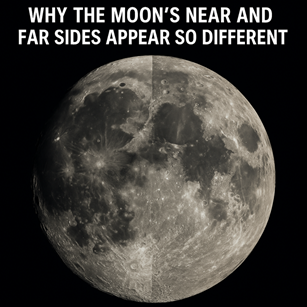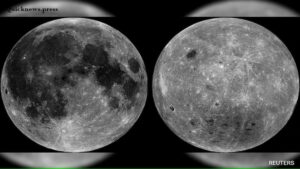A new study reveals why the Moon’s two sides look so different. Learn what causes the contrast between its near and far sides, backed by NASA data.

🌕 Why The Moon’s Two Sides Look So Different: Latest Study Reveals Truth
A groundbreaking study published in May 2025 has finally unraveled a mystery that has puzzled scientists for decades: Why do the Moon’s near side and far side appear so different? Conducted by a joint research team from NASA and China’s space agency (CNSA), this study offers the clearest explanation yet—and it’s all about ancient collisions and internal heat.
Let’s dive deep into what makes our Moon’s two faces so unique and how the new findings are reshaping what we thought we knew about Earth’s natural satellite.
🌑 Trending: “Moon’s Far Side Composition Mystery Solved in 2025”
📌 Near Side vs Far Side of the Moon: What’s the Big Difference?
- Near Side: Always faces Earth; features large, dark plains known as lunar maria.
- Far Side: Hidden from Earth, covered in cratered highlands with very little maria.
🧬 Why the Moon’s Faces Differ: Scientific Explanation
According to the latest peer-reviewed study in Nature Geoscience, the reason behind this stark difference lies in the massive impact of a celestial object shortly after the Moon formed—over 4.4 billion years ago.
🔍 Key Findings:
- A massive impactor likely hit the Moon’s far side.
- The impact created a heat wave that traveled to the near side.
- This heat concentrated radioactive elements like potassium (K), thorium (Th), and uranium (U).
- These elements melted the near side’s crust, forming large basalt plains—the lunar maria.
“This explains why the near side is smoother and darker, while the far side remains rugged and ancient,” said Dr. Meng Hua Zhu, co-author of the study and a planetary scientist at Macau University of Science and Technology.
🔬 Data Table: Moon Composition Differences
| Feature | Near Side | Far Side |
|---|---|---|
| Crust Thickness | Thinner (~30 km) | Thicker (~50 km) |
| Element Concentration | Higher K, Th, U | Lower radioactive elements |
| Surface Appearance | Dark, smooth maria | Bright, heavily cratered |
| Visible from Earth? | Yes | No |
🌍 Internal Heat Distribution Explained
A major takeaway is how asymmetric heat flow after the Moon’s formation helped shape its surface. The hotter near side allowed volcanic activity, while the far side stayed cooler and preserved older terrain.
This discovery refines models of lunar evolution and even offers clues about how other rocky planets might have formed.
🌐 Expert Insight: Why This Study Matters in 2025
“The Moon acts like a fossilized record of early planetary history,” says Dr. James Head, planetary geologist at Brown University. “Understanding its formation helps us decode the history of Earth and Mars too.”
The timing is crucial, as NASA’s Artemis III mission, planned for late 2026, will explore the Moon’s south pole, bringing back samples that could validate this theory.
❓ FAQs: Why Moon’s Two Sides Look Different
1. Why does the Moon always show the same side to Earth?
Because of tidal locking, the Moon’s rotation period matches its orbit around Earth, always showing the near side.
2. Is the far side of the Mooon completely dark?
No. It’s often called the “dark side,” but it receives sunlight just like the near side—it’s just not visible from Earth.
3. What is the lunar maria?
They are large, dark basalt plains formed by ancient volcanic eruptions—mostly found on the near side.
4. Can we visit the far side of the Mooon?
Yes. China’s Chang’e-4 mission was the first to successfully land on the far side in 2019.
5. What causes more craters on the Mooon’s far side?
The far side’s thicker crust made it harder for lava to fill in craters, preserving its rugged look.
Related: NASA’s Artemis Program Explained in Detail
📣 Call to Action
🔭 Love space exploration?
👉 Share this article, follow us for more science breakthroughs, and leave a comment on what mystery you’d like scientists to solve next!
🧠 Final Thought:
This research not only solves a lunar mystery but also enhances our understanding of planetary development across the solar system. As new missions gather more data, we may soon uncover even deeper truths about our Moon—and beyond.





